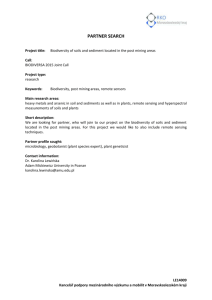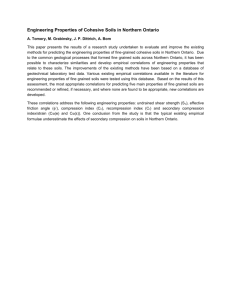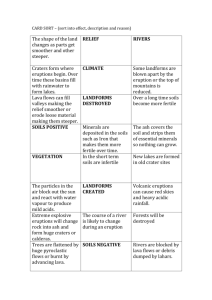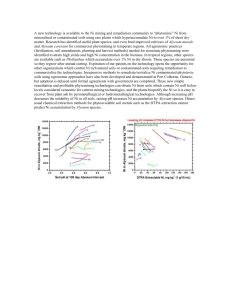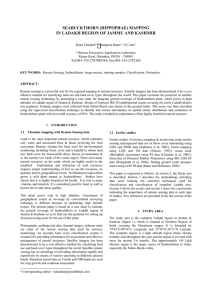The capabilities of seabuckthorn (Hippophae rhamnoides L.)
advertisement
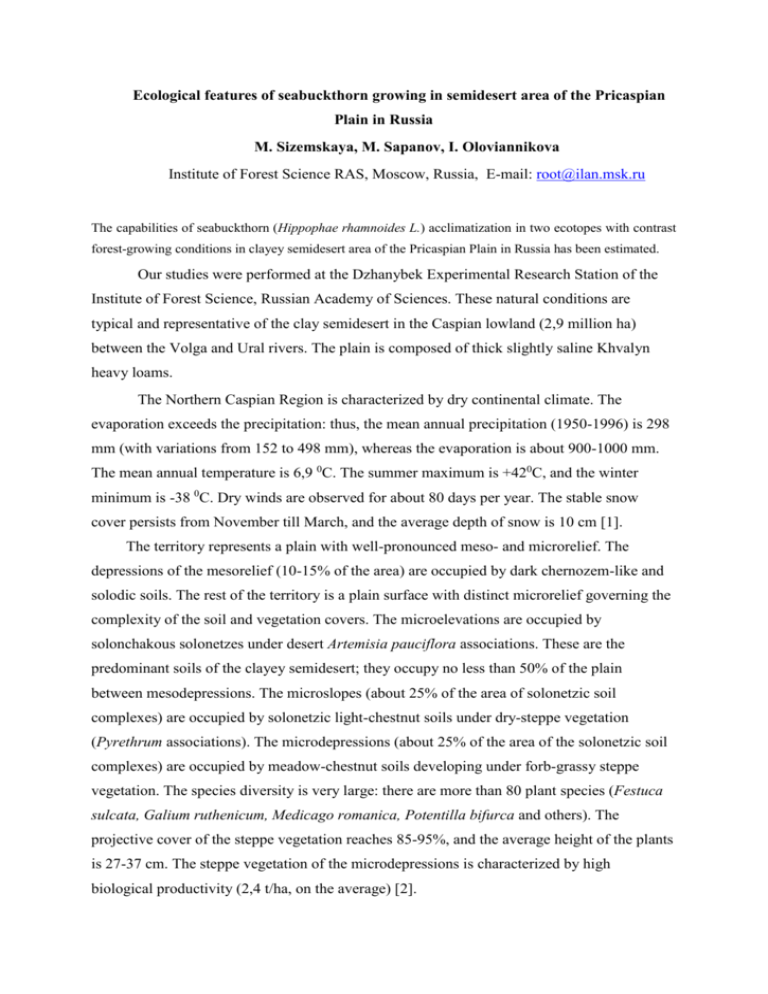
Ecological features of seabuckthorn growing in semidesert area of the Pricaspian Plain in Russia M. Sizemskaya, M. Sapanov, I. Oloviannikova Institute of Forest Science RAS, Moscow, Russia, E-mail: root@ilan.msk.ru The capabilities of seabuckthorn (Hippophae rhamnoides L.) acclimatization in two ecotopes with contrast forest-growing conditions in clayey semidesert area of the Pricaspian Plain in Russia has been estimated. Our studies were performed at the Dzhanybek Experimental Research Station of the Institute of Forest Science, Russian Academy of Sciences. These natural conditions are typical and representative of the clay semidesert in the Caspian lowland (2,9 million ha) between the Volga and Ural rivers. The plain is composed of thick slightly saline Khvalyn heavy loams. The Northern Caspian Region is characterized by dry continental climate. The evaporation exceeds the precipitation: thus, the mean annual precipitation (1950-1996) is 298 mm (with variations from 152 to 498 mm), whereas the evaporation is about 900-1000 mm. The mean annual temperature is 6,9 0C. The summer maximum is +420C, and the winter minimum is -38 0C. Dry winds are observed for about 80 days per year. The stable snow cover persists from November till March, and the average depth of snow is 10 cm [1]. The territory represents a plain with well-pronounced meso- and microrelief. The depressions of the mesorelief (10-15% of the area) are occupied by dark chernozem-like and solodic soils. The rest of the territory is a plain surface with distinct microrelief governing the complexity of the soil and vegetation covers. The microelevations are occupied by solonchakous solonetzes under desert Artemisia pauciflora associations. These are the predominant soils of the clayey semidesert; they occupy no less than 50% of the plain between mesodepressions. The microslopes (about 25% of the area of solonetzic soil complexes) are occupied by solonetzic light-chestnut soils under dry-steppe vegetation (Pyrethrum associations). The microdepressions (about 25% of the area of the solonetzic soil complexes) are occupied by meadow-chestnut soils developing under forb-grassy steppe vegetation. The species diversity is very large: there are more than 80 plant species (Festuca sulcata, Galium ruthenicum, Medicago romanica, Potentilla bifurca and others). The projective cover of the steppe vegetation reaches 85-95%, and the average height of the plants is 27-37 cm. The steppe vegetation of the microdepressions is characterized by high biological productivity (2,4 t/ha, on the average) [2]. The salinity of the ground water is rather uneven: sulfate salinization is detected under the solonetzes (up to 20 g/l) and light-chestnut soils (up to 10 g/l), whereas bicarbonate salinization (<1 g/l) is developed under the meadow-chestnut soils of the microdepressions and under the chernozem-like and solodic soils of the mesodepressions. Ground water table occurs at the depth of 5-6 m. The thickness of capillary fringe is 3 m. Experiments on introduction of wood and shrub plants at the Dzhanybek Research Station are spent from the beginning of 50th years. The first ecotope with favorable ecological conditions is confined within large depressions of mesorelief with a lens of fresh ground water at the depth of 5-6 m and intrazonal meadow-chestnut non-saline soils. More than 200 species of trees and shrubs from different continents and geographical zones have been tested in the mesodepressions on the meadow-chesnut soils, where underground water is weakly mineralized and available to plants. Many introduced trees are well adapted to severe semidesert climatic conditions. They grow well and quickly, begin to produce fruits at young age, and have abundant natural regeneration. The best growth and stability were found for trees typical for broad-leaved forests on steep slopes and valley forests of the forest-steppe zone, and flood-plain forests. They include mesophytes and mesoxerophytes: oak, birch, lime, pear tree, maple, mountain ash, and hazel nut. 96 forest species may be recommended for planting in mesodepressions. Agrotechnical care may be taken only in the first years at correct selection of tree species. Further growth of dense forests is regulated by interspecies and intraspecies competition between sanitary tree cuttings. Tree plantations acquire features of natural forest communities. They are characterized by changes in the pH regime of soils, appearance of forest fauna and mycoflora (mycorhiza saprophyte fungi), and accumulation of forest litter [5]. In this ecotope the seabuckthorn is represented by high-standing shrubbery up to 5 - 6,5 m high with the leading shoot up to 7-9 cm high (18 cm maximum) at the age of 25 years (Foto 1). Foto 1. The seabuckthorn plants (at the age of 25 years) on the meadow-chestnut soils in mesodepressions The seabuckthorn plants are alternately fruit-bearing and annually produce viable root suckers at a distance of 7-8 m from the plant; the plants compete successfully with other species introduced for the living space and so they do not require particular agrotechnical or forest-growing measures. The plant roots reach the upper boundary of the capillary fringe which is found at the depth of 2-3 m. The most important factor of seabuckthorn plants survival is the presence of fresh ground water which is the only source of moisture for transpiration during the dry periods (in the second half of the growing season). The second ecotope is confined within the soils of solonetz complex. In solonchakous (salt-affected) solonetz soils the percentage of soluble salts beginning from the depth 1,5 m exceeds 3%, the ground water being highly mineralized (5-10 g/l). Salt-affected soils cannot be used for afforestation and cultivation without preliminary amelioration. At first some desalinization and dealcalinization of soils is achieved by deep plowing, which destroys the solonetzic horizon, involves gypsum from the first subsolonetzic horizon into the plow layer and causes the increase in the water permeability of the topsoil. Further desalinization of these soils occurs due to additional moistening caused by snow accumulation with the system of one-row strips of elm (Ulmus pumila L). On ameliorated soils of solonetzic complex the best growth and the highest tolerance was recorded for steppe xerophytes. 13 species have been proved to be the most tolerant and long living (barberry, June berry, lilac, cotoneaster, ash tree, and others). 21 species may be sowed directly into microdepressions [3]. Small areas of soils in solonetzic complexes are favorable for the introduced plants: their root systems may use moisture not only from the solonetzes but also from the adjacent not afforested depressions. On ameliorated soils of solonetzic complex the stunted seabuckthorn plants are only 1,5 m high at the age of 15 years, they have the superficial root system (Fig. 1), occurring within the upper 1 m layer and are subject to drying because of the moisture deficit (150 mm during the warm and cold halves of the year). Fig 1. The root system of seabuckthorn (at the age of 14 years) on ameliorated solonchakous solonetz (by [3]): A – the moisture in autumn; B – the salt profile: K+: _____ Na+, _ _ _ Ca2+, ………Mg2+, A-: _____ SO42-, _ _ _ HCO3-, ………Cl-. C – the root system. 1 – 4 – soil horizons: 1 – Ap ca, 2 – B3 ca2 cs2, 3 – B3 ca cs2sa2, 4 – BC ca cs2sa2 To improve the seabuckthorn plantations it is necessary to provide broad inter-row spacing (up to 6- 10 m) in order to extend the water supply area; it is also recommended to implement annual agrotechnical treatment to decrease the evaporation from the soil surface and to suppress the competition of weeds for the available soil moisture. However even in this case the probability of the seabuckthorn plants death is rather high due to essential fluctuations in the annual precipitation. Unexpected continuation the introduction experiment has received in thrown artificial to career where after several years it was formed woody-shrub community of self-sowing plants of Elaeagnus oxycarpa, willows with participation of poplars, sea-buckthorn and berry bushes [4]. These plants (the representatives of 36 species) have independently occupied slopes and the bottom career, having generated wood biogeocenosis quasitugai shape (Foto 2). Foto 2. The artificial career with spontaneously appeared woody and shrub vegetation Seabuckthorn berries are playing the appreciable role here. In the age of 10 years, plants have height of 3-4 m, diameter of 6-7 cm, a sprawling crone and an excellent healthy state. The seabuckthorn grow as at the bottom together with representatives damp-meadow motley grass (Calamagrostis epigeios, a reed), and on drier slopes (with Festuca sulcata, Artemisia Lercheana, Lucerne). It testifies to good adaptive reactions of seabuckthorn, its wide ecological amplitude, opportunities of its use for desertification control and development of erosion in these conditions. Foto 3. The bottom, which is occupied by seabuckthorn plants Foto 4. The slopes, which are occupied by seabuckthorn plants Thus the planting of seabuckthorn plants in the clayey semidesert area seems to be promising in the depressions of mesorelief with intrazonal ecological conditions and available fresh ground water. The creation of multifunctional plantations in these areas makes it possible to optimize the land utilization and amelioration of environment . REFERENCES 1. Biogeocoenotic Bases for the Development of North Caspian Semidesert. 1974, Moscow. 360 p. (in Russian). 2. Rode A., Polsky M. 1961. Soils of Dzhanybek Research Station: Morphology, Texture, Chemical Composition and Physical Properties. Trudy Dokutch. Soil Inst. Vol. 56, pp. 1-214. (in Russian). 3. Senkevich N., Oloviannikova I. 1996. Introduction of woody plants in Northern Caspian Semidesert. Moscow. 180 p. (in Russian). 4. Sizemskaya M., Kopyl I., Sapanov M. 1995. Colonization of artificial mesorelief lowland by wood and shrub vegetation in semidesert of the Caspian sea region. Lesovedenie. № 1. Pp. 15-23 (in Russian). 5. Vomperskii S., Oloviannikova I. , Bazykina G., Sapanov M., Sizemskaya M. 2000. The main results of biogeocenotic investigations and application of agroforestry practices in the Northern Caspian Semidesert. Eurasian soil science. Vol. 33. № 11. Pp. 1305-1317. ACKNOWLEDGMENTS This study was supported by the Russian Foundation for Basic Research, project № 03-0448076.


